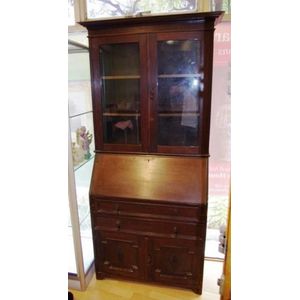Georgian Mahogany Shaving Mirror with Satinwood Stringing
You must be a subscriber, and be logged in to view price and dealer details.
Subscribe Now to view actual auction price for this item
When you subscribe, you have the option of setting the currency in which to display prices to $Au, $US, $NZ or Stg.
- Georgian - As an English stylistic period, Georgian is usually taken to cover the period from George I (1714) to the Regency of Prince George (1811-20), although the period from 1800 to 1830 is sometimes designated as the Regency period. During the Georgian period the great English cabinetmakers and designers such as Chippendale, Hepplewhite, Adam Sheraton etc., were all active.
Therefore there isn't a single 'Georgian style' as such and to say something is 'Georgian', usually means it was made between 1714 and 1830. This assumes we discount George V and George VI, both being from the 20th century.
The styles popular at the time of each reign were:
George I (1714-1727) saw out the last years of the Baroque period.
George II (1727-1760) reigned during the Rococo period.
George III (1760-1820) saw the last gasp of the Rococo, all of the early Neo-Classic 'Adam style' and most of the later neo-Classic 'Regency style'.
George IV (Prince Regent 1820-1830)encompassed the last of the 'Regency' style.
William IV's reign (1830-1837) was something of a no man's land (stylistically) and he wasn't a 'George' anyway. He covered the last glimmerings of 'Regency' and the start of the 'Victorian' style. - Mahogany - Mahogany is a dense, close grained red-coloured timber from the West Indies and Central America. It was first imported into Europe in the the early 18th century and its use continued through the 19th century. It was popular for furniture making because of its strength, the wide boards available, the distinctive grain on some boards, termed flame mahogany and the rich warm colour of the timber when it was polished.. The "flame" was produced where a limb grew out from the trunk of the tree, and this timber was usually sliced into veneers for feature panels on doors, backs and cornices.
Some terms used to describe mahogany relate to the country from which it originally came, such as "Cuban" mahogany, "Honduras" mahogany etc. However unless the wood has been tested the names assigned are more a selling feature, rather than a true indication of the timber's origin. - Satinwood - Satinwood is a dense pale gold coloured timber that was imported into Britain in the second half of the 18th century, and early 19th centuries from the East Indies and the West Indies. The name derives from the satin-like surface sheen when the timber is polished.
It was used in the solid, as a veneer and in inlays. As well as furniture, satinwood was used for making musical instruments, barometers, boxes and clocks.
It will usually be found on only the very best quality objects, presumably because of of its cost at the time. - Ogee - A serpentine shape, usually convex at the upper part, concave at the lower. Mostly used to describe the front shapes of parts of carcass furniture, such as cornices, drawer fronts and feet.
- Bracket Feet - On bracket feet the corner edge is square and joined by a mitre to its partner on the opposite angle. The inner edge is usually shaped or scalloped. Bracket feet were first introduced in the early 18th century and used until c. 1830 and are found on carcase furniture such as chests, cabinets, bookcases and bureaux.
Ogee bracket feet, a variation on straight bracket feet, have the outside edge forming an "S" shaped curve with the top bulging outward and the bottom turning inward.
On splayed bracket feet, the exterior edge curves outward. - Finial - An architectural decoration, found on the upper parts of of an object. On furniture they are usually found on pediments, canopies and shelf supports. On smaller ceramic or silver items, such as spoons, they may decorate the top of the item itself, or the lid or cover where they provide a useful handle for removal.
Finials have a variety of shapes and forms. They may be urn-shaped, baluster shaped round or spiral, but usually taper into an upper point. Many real life shapes may also be used as finials, such as pineapples, berries, pinecones, buds, lotus and acorns. Sometimes animals such as a lion are depicted, or fish and dolphins. - Stringing - Fine inlaid lines, in contrasting colour to the carcase timber, found mainly on furniture made in the styles of the later 18th and early 19th centuries. Stringing, which may be of satinwood, pine, ebony, horn, brass or occasionally ivory, is found principally on drawer fronts, around the outer edges of usually tapered legs and French bracket feet, around the edges of inlaid panels and between the joint of the cross banding and carcase timber on table tops, chests of drawers, cabinets etc. The effect is to emphasize the line of the piece and add to the impression of lightness and elegance. Stringing also occurs in Sheraton-revival-style furniture of the later 19th and early 20th centuries.
This item has been included into following indexes:
Visually similar items

A George III flame mahogany toilet swing mirror, the box base with three shaped drawers, ogee bracket feet, turned bone urn finials. Height 63 cm

Antique 19th century mahogany two height, two door secretaire bookcase, glazed two door top with applied carved corbels, approx 215 cm high, 120 cm wide, 49 cm deep

A good pair of French walnut breakfront library bookcases, with a moulded cornice and frieze above a large glazed door flanked by smaller doors and fluted pilasters on bun feet. 152 cm high, 198 cm wide 51 cm deep

Vintage oak bureau bookcase, with glazed door bookcase over 4 front bureau, 2 drawers and 2 doors, 86 cm wide, 194 cm high
